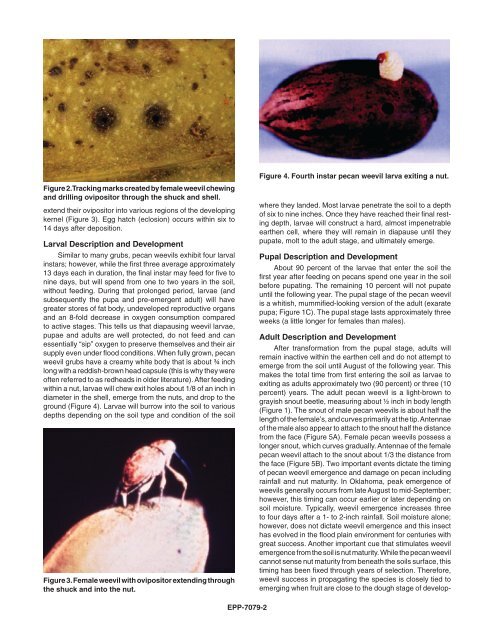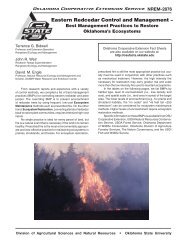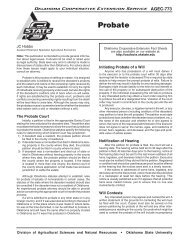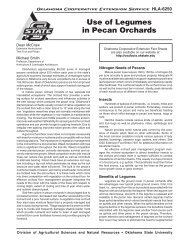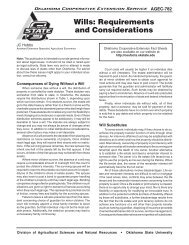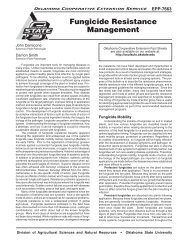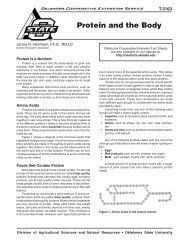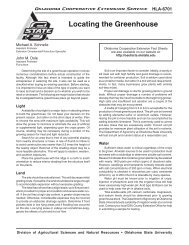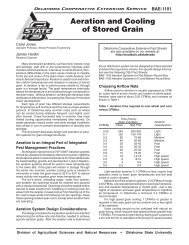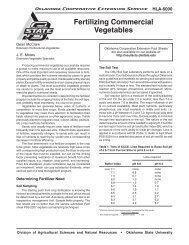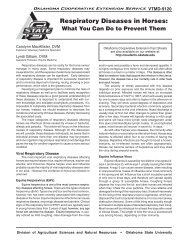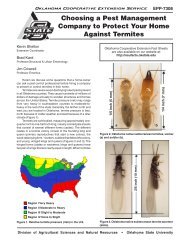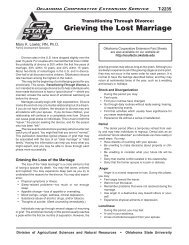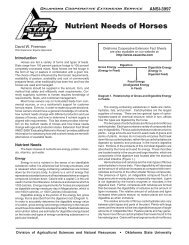Biology and Control of the Pecan Weevil in Oklahoma - OSU Fact ...
Biology and Control of the Pecan Weevil in Oklahoma - OSU Fact ...
Biology and Control of the Pecan Weevil in Oklahoma - OSU Fact ...
Create successful ePaper yourself
Turn your PDF publications into a flip-book with our unique Google optimized e-Paper software.
Figure 4. Fourth <strong>in</strong>star pecan weevil larva exit<strong>in</strong>g a nut.<br />
Figure 2. Track<strong>in</strong>g marks created by female weevil chew<strong>in</strong>g<br />
<strong>and</strong> drill<strong>in</strong>g ovipositor through <strong>the</strong> shuck <strong>and</strong> shell.<br />
extend <strong>the</strong>ir ovipositor <strong>in</strong>to various regions <strong>of</strong> <strong>the</strong> develop<strong>in</strong>g<br />
kernel (Figure 3). Egg hatch (eclosion) occurs with<strong>in</strong> six to<br />
14 days after deposition.<br />
Larval Description <strong>and</strong> Development<br />
Similar to many grubs, pecan weevils exhibit four larval<br />
<strong>in</strong>stars; however, while <strong>the</strong> first three average approximately<br />
13 days each <strong>in</strong> duration, <strong>the</strong> f<strong>in</strong>al <strong>in</strong>star may feed for five to<br />
n<strong>in</strong>e days, but will spend from one to two years <strong>in</strong> <strong>the</strong> soil,<br />
without feed<strong>in</strong>g. Dur<strong>in</strong>g that prolonged period, larvae (<strong>and</strong><br />
subsequently <strong>the</strong> pupa <strong>and</strong> pre-emergent adult) will have<br />
greater stores <strong>of</strong> fat body, undeveloped reproductive organs<br />
<strong>and</strong> an 8-fold decrease <strong>in</strong> oxygen consumption compared<br />
to active stages. This tells us that diapaus<strong>in</strong>g weevil larvae,<br />
pupae <strong>and</strong> adults are well protected, do not feed <strong>and</strong> can<br />
essentially “sip” oxygen to preserve <strong>the</strong>mselves <strong>and</strong> <strong>the</strong>ir air<br />
supply even under flood conditions. When fully grown, pecan<br />
weevil grubs have a creamy white body that is about ¾ <strong>in</strong>ch<br />
long with a reddish-brown head capsule (this is why <strong>the</strong>y were<br />
<strong>of</strong>ten referred to as redheads <strong>in</strong> older literature). After feed<strong>in</strong>g<br />
with<strong>in</strong> a nut, larvae will chew exit holes about 1/8 <strong>of</strong> an <strong>in</strong>ch <strong>in</strong><br />
diameter <strong>in</strong> <strong>the</strong> shell, emerge from <strong>the</strong> nuts, <strong>and</strong> drop to <strong>the</strong><br />
ground (Figure 4). Larvae will burrow <strong>in</strong>to <strong>the</strong> soil to various<br />
depths depend<strong>in</strong>g on <strong>the</strong> soil type <strong>and</strong> condition <strong>of</strong> <strong>the</strong> soil<br />
Figure 3. Female weevil with ovipositor extend<strong>in</strong>g through<br />
<strong>the</strong> shuck <strong>and</strong> <strong>in</strong>to <strong>the</strong> nut.<br />
where <strong>the</strong>y l<strong>and</strong>ed. Most larvae penetrate <strong>the</strong> soil to a depth<br />
<strong>of</strong> six to n<strong>in</strong>e <strong>in</strong>ches. Once <strong>the</strong>y have reached <strong>the</strong>ir f<strong>in</strong>al rest<strong>in</strong>g<br />
depth, larvae will construct a hard, almost impenetrable<br />
ear<strong>the</strong>n cell, where <strong>the</strong>y will rema<strong>in</strong> <strong>in</strong> diapause until <strong>the</strong>y<br />
pupate, molt to <strong>the</strong> adult stage, <strong>and</strong> ultimately emerge.<br />
Pupal Description <strong>and</strong> Development<br />
About 90 percent <strong>of</strong> <strong>the</strong> larvae that enter <strong>the</strong> soil <strong>the</strong><br />
first year after feed<strong>in</strong>g on pecans spend one year <strong>in</strong> <strong>the</strong> soil<br />
before pupat<strong>in</strong>g. The rema<strong>in</strong><strong>in</strong>g 10 percent will not pupate<br />
until <strong>the</strong> follow<strong>in</strong>g year. The pupal stage <strong>of</strong> <strong>the</strong> pecan weevil<br />
is a whitish, mummified-look<strong>in</strong>g version <strong>of</strong> <strong>the</strong> adult (exarate<br />
pupa; Figure 1C). The pupal stage lasts approximately three<br />
weeks (a little longer for females than males).<br />
Adult Description <strong>and</strong> Development<br />
After transformation from <strong>the</strong> pupal stage, adults will<br />
rema<strong>in</strong> <strong>in</strong>active with<strong>in</strong> <strong>the</strong> ear<strong>the</strong>n cell <strong>and</strong> do not attempt to<br />
emerge from <strong>the</strong> soil until August <strong>of</strong> <strong>the</strong> follow<strong>in</strong>g year. This<br />
makes <strong>the</strong> total time from first enter<strong>in</strong>g <strong>the</strong> soil as larvae to<br />
exit<strong>in</strong>g as adults approximately two (90 percent) or three (10<br />
percent) years. The adult pecan weevil is a light-brown to<br />
grayish snout beetle, measur<strong>in</strong>g about ½ <strong>in</strong>ch <strong>in</strong> body length<br />
(Figure 1). The snout <strong>of</strong> male pecan weevils is about half <strong>the</strong><br />
length <strong>of</strong> <strong>the</strong> female’s, <strong>and</strong> curves primarily at <strong>the</strong> tip. Antennae<br />
<strong>of</strong> <strong>the</strong> male also appear to attach to <strong>the</strong> snout half <strong>the</strong> distance<br />
from <strong>the</strong> face (Figure 5A). Female pecan weevils possess a<br />
longer snout, which curves gradually. Antennae <strong>of</strong> <strong>the</strong> female<br />
pecan weevil attach to <strong>the</strong> snout about 1/3 <strong>the</strong> distance from<br />
<strong>the</strong> face (Figure 5B). Two important events dictate <strong>the</strong> tim<strong>in</strong>g<br />
<strong>of</strong> pecan weevil emergence <strong>and</strong> damage on pecan <strong>in</strong>clud<strong>in</strong>g<br />
ra<strong>in</strong>fall <strong>and</strong> nut maturity. In <strong>Oklahoma</strong>, peak emergence <strong>of</strong><br />
weevils generally occurs from late August to mid-September;<br />
however, this tim<strong>in</strong>g can occur earlier or later depend<strong>in</strong>g on<br />
soil moisture. Typically, weevil emergence <strong>in</strong>creases three<br />
to four days after a 1- to 2-<strong>in</strong>ch ra<strong>in</strong>fall. Soil moisture alone;<br />
however, does not dictate weevil emergence <strong>and</strong> this <strong>in</strong>sect<br />
has evolved <strong>in</strong> <strong>the</strong> flood pla<strong>in</strong> environment for centuries with<br />
great success. Ano<strong>the</strong>r important cue that stimulates weevil<br />
emergence from <strong>the</strong> soil is nut maturity. While <strong>the</strong> pecan weevil<br />
cannot sense nut maturity from beneath <strong>the</strong> soils surface, this<br />
tim<strong>in</strong>g has been fixed through years <strong>of</strong> selection. Therefore,<br />
weevil success <strong>in</strong> propagat<strong>in</strong>g <strong>the</strong> species is closely tied to<br />
emerg<strong>in</strong>g when fruit are close to <strong>the</strong> dough stage <strong>of</strong> develop-<br />
EPP-7079-2


